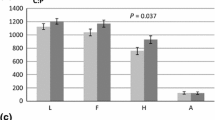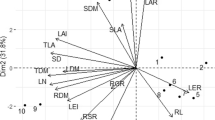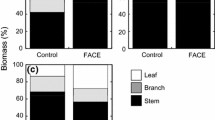Abstract
Populus × euramericana, P. alba, and P. nigra clones were exposed to ambient or elevated (about 550 ppm) CO2 concentrations under field conditions (FACE) in central Italy. After three growing seasons, the plantation was coppiced. FACE was continued and in addition, one-half of each experimental plot was fertilised with nitrogen. Growth and anatomical wood properties were analysed in secondary sprouts. In the three poplar clones, most of the growth and anatomical traits showed no uniform response pattern to elevated [CO2] or N-fertilisation. In cross-sections of young poplar stems, tension wood amounted to 2–10% of the total area and was not affected by elevated CO2. In P. nigra, N-fertilisation caused an about twofold increase in tension wood, but not in the other clones. The formation of tension wood was not related to diameter or height growth of the shoots. In P. × euramericana N-fertilisation resulted in significant reductions in fibre lengths. In all three genotypes, N-fertilisation caused significant decreases in cell wall thickness. In P. × euramericana and P. alba elevated [CO2] also caused decreases in wall thickness, but less pronounced than nitrogen. In P. nigra and P. × euramericana elevated [CO2] induced increases in vessel diameters. These results show that elevated [CO2] and N-fertilisation affect wood structural development in a clone specific manner. However, the combination of these environmental factors resulted in overall losses in cell wall area of 5–12% in all three clones suggesting that in future climate scenarios negative effects on wood quality are to be anticipated if increases in atmospheric CO2 concentration were accompanied by increased N availability.




Similar content being viewed by others
References
Atkinson CJ, Taylor JM (1996) Effects of elevated CO2 on stem growth, vessel area and hydraulic conductivity of oak and cherry seedlings. New Phytol 133:617–626
Brix H (1981) Effects of nitrogen fertilizer source and application rates on foliar nitrogen concentration, photosynthesis, and growth of Douglas-fir. Can J For Res 11:775–780
Brolin A, Noren A, Stähle E (1995) Wood and pulp characteristics of juvenile Norway spruce: a comparison between a forest and an agricultural stand. Tappi J 78:203–214
Calfapietra C, Gielen B, Sabatti M, Angelis PD, Mugnozza GS, Ceulemans R (2001) Growth performance of Populus exposed to “Free Air Carbon Dioxide Enrichment” during the first growing season in the POPFACE experiment. Ann For Sci 58:819–828
Calfapietra C, Gielen B, Galema ANJ, Lukac M, Angelis PD, Moscatelli MC, Ceulemans R, Mugnozza GS (2003a) Free-air CO2 enrichment (FACE) enhances biomass production in a short-rotation poplar plantation. Tree Physiol 23:805–814
Calfapietra C, Gielen B, Sabatti M, Angelis PD, Miglietta F, Mugnozza GS, Ceulemans R (2003b) Do above-ground growth dynamics of poplar change with time under CO2 enrichment? New Phytol 160:305–318
Ceulemans R, Jach ME, Velde RVD, Lin JX, Stevens M (2002) Elevated atmospheric CO2 alters wood production, wood quality and wood strength of Scots pine (Pinus sylvestris L) after three years of enrichment. Global Change Biol 8:153–162
Chalk L, Chattaway MM (1934) Measuring the length of vessel members. Trop Woods 40:19–26
Conroy JP, Milham PJ, Mazur M, Barlow EWR (1990) Growth, dry matter partitioning and wood properties of Pinus radiata D. Don. after 2 years of CO2 enrichment. Plant Cell Environ 13:329–337
Cooke JEK, Brown KA, Wu R, Davis JM (2003) Gene expression associated with N-induced shifts in resource allocation in poplar. Plant Cell Environ 26:757–770
Donaldson LA, Hollinger D, Middleton TM, Souter ED (1987) Effect of CO2 enrichment on wood structure in Pinus radiata D. Don. IAWA Bull New Ser 8:285–289
Dutilleul P, Herman M, Avella ST (1998) Growth rate effects on correlations among ring width, wood density, and mean tracheid length in Norway spruce (Picea abies). Can J For Res 28:56–68
Gartner B, Roy J, Huc R (2003) Effects of tension wood on specific conductivity and vulnerability to embolism of Quercus ilex seedlings grown at two atmospheric CO2 concentrations. Tree Physiol 23:387–395
Gielen B, Ceulemans R (2001) The likely impact of rising atmospheric CO2 on natural land and managed Populus: a literature review. Environ Pollut 115:335–358
Gross K (2002) Wachstum und Sekundärstoffwechsel von Wildtyp und transgenen Pappeln (Populus × canescens [AIT.] SM.) unter ambienten und erhöhten atmosphärischen CO2-Konzentrationen. In: 6-IV Cell wall composition under elevated CO2. Cuvillier, Göttingen, pp 1–16
Günthardt-Goerg MS, Schmutz P, Matyssek R, Bucher JB (1996) Leaf and stem structure of poplar (P. × euramericana) as influenced by O3, NO3, their combination, and different soil N supplies. Can J For Res 26:649–657
Hargrave KR, Kolb KJ, Ewers FW, Davis SD (1994) Conduit diameter and drought-induced embolism in Salvia millifera Greene (Labiatae). New Phytol 126:695–705
Hättenschwiler S, Schweingruber FH, Körner C (1996) Tree ring responses to elevated CO2 and increased N deposition in Picea abies. Plant Cell Environ 19:1369–1378
Hovenden MJ (2003) Photosynthesis of coppiced poplar clones in a free-air CO2 enrichment (FACE) experiment in a short-rotation forest. Funct Plant Biol 30:391–400
Huang Y, Eglinton G, Ineson P, Bol R, Harkness D (1999) The effects of nitrogen fertilisation and elevated CO2 on the lipid biosynthesis and carbon isotopic discrimination in birch seedlings (Betula pendula). Plant Soil 216:35–45
Jach ME, Ceulemans R (1999) Effects of elevated atmospheric CO2 on phenology, growth and crown structure of Scots pine (Pinus sylvestris) seedlings after two years of exposure in the field. Tree Physiol 19:289–300
Kitin P, Funada R, Sano Y, Beechman H, Ohtani J (1999) Variations in the lengths of fusiform cambial cells and vessel elements in Kalopanax pictus. Anal Bot 84:621–632
Lindström H (1996) Basic density in Norway spruce. I. A literature review. Wood Fiber Sci 28:15–27
Mäkinen H, Saranpää P, Linder S (2002) Wood density variation of Norway spruce in relation to nutrient optimisation and fibre dimensions. Can J For Res 32:185–194
McGuire AD, Melillo JM, Kicklighter DW, Grace AL, Moore B, Vorosmarty CJ (1992) Interactions between carbon and nitrogen dynamics in estimating net primary productivity for potential vegetation in North America. Global Biogeochem Cycles 6:101–124
McGuire AD, Joyce LA, Kicklighter DW, Melillo JM, Esser G, Vorosmarty CJ (1993) Productivity response of climax temperate forests to elevated temperature and carbon dioxide: a North American comparison between two global models. Clim Change 24:287–310
Medlyn BE, Badeck FW, De Pury DGG, Barton CVM, Broadmeadow M, Ceulemans R, De Angelis P, Forstreuter M, Jach ME, Kellomäki S, Laitat E, Marek M, Philippot S, Rey A, Strassemeyer J, Laitinen K, Liozon R, Portier B, Roberntz P, Wang K, Jarvis PG (1999) Effects of elevated [CO2] on photosynthesis in European forest species: a meta-analysis of model parameters. Plant Cell Environ 22:1475–1495
Melillo JM, McGuire AD, Kicklighter DW, Moore B III, Vorosmarty CJ, Schloss AL (1993) Global climate change and terrestrial net primary production. Nature 363:234–240
Miglietta F, Peressotti A, Vaccari FP, Zaldei A, DeAngelis P, Mugnozza GS (2001) Free-air CO2 enrichment (FACE) of a poplar plantation: the POPFACE fumigation system. New Phytol 150:465–476
Pape R (1999) Effects of thinning regime on the wood properties and stem quality of Picea abies. Scand J For Res 14:38–50
Peltola H, Kilpeläinen A, Kellomäki S (2002) Diameter growth of Scots pine (Pinus sylvestris) trees grown at elevated temperature and carbon dioxide concentration under boreal conditions. Tree Physiol 22:963–972
Prior SA, Runion GB, Mitchell RJ, Rogers HH, Amthor SJ (1997) Effects of atmospheric CO2 on longleaf pine: productivity and allocation as influenced by nitrogen and water. Tree Physiol 17:397–405
Pritchard SG, Rogers HH, Prior SA, Peterson CM (1999) Elevated CO2 and plant structure: a review. Global Change Biol 5:807–837
Purvis MJ, Collier DC, Walls D (1966) Some useful tests for biologically important substances. In: Laboratory techniques in botany, 2nd edn. Butterworth, London
Saxe H, Ellsworth DS, Heath J (1998) Tree and forest functioning in an enriched CO2 atmosphere. New Phytol 139:395–436
Schmidtling RC (1973) Intensive culture increases growth without affecting wood quality of young southern pines. Can J For Res 3:565–573
Shupe TF, Choong ET, Yang CH (1996) The effects of silvicultural treatments on the chemical composition of plantation-grown loblolly pine wood. Wood Fiber Sci 28:295–300
Telewski FW, Swanson RT, Strain BR, Burns JM (1999) Wood properties and ring width response to long-term atmospheric CO2 enrichment in field-grown loblolly pine (Pinus taeda L.). Plant Cell Environ 22:213–223
Tyree MT, Davis SD, Cochard H (1994) Biophysical perspectives of xylem evolution: Is there a tradeoff of hydraulic efficiency for vulnerability to dysfunction? IAWA J 15:335–360
Ward JK, Strain BR (1999) Elevated CO2 studies: past, present and future. Tree Physiol 19:211–220
Wullschleger SD, Post WM, King AW (1995) On the potential for a CO2 fertilization effect in forests: estimates of the biotic growth factor based on 58 controlled-exposure studies. In: Woodwell GM, Mackenzie FT (eds) Biotic feedbacks in the global climatic system. Oxford University Press, New York, pp 85–107
Yang RC, Wang EIC, Micko MM (1988) Effects of fertilisation on wood density and tracheid length of 70-year-old lodgepole pine in west-central Alberta. Can J For Res 18:954–956
Yazaki K, Funada R, Mori S, Maruyama Y, Abaimov A, Kayama M, Koike T (2001) Growth and annual ring structure of Larix sibirica grown at different carbon dioxide concentrations and nutrient supply rates. Tree Physiol 21:1223–1229
Zobel BJ, Van Buijtenen JP (1989) Wood variation: its causes and control. Springer, Berlin Heidelberg New York
Acknowledgements
We are grateful to the European Union (contract number: EVR1-CT-2002-40027) and the Programme “Nachwuchswissenschaftler aus auβereuropäischen Ländern nach Niedersachsen” for financial support. Christine Kettner, Gisbert Langer-Kettner, Michael Reichel, Rainer Schulz and Thomas Klein are acknowledged for their assistance with sample collection in the field.
Author information
Authors and Affiliations
Corresponding author
Rights and permissions
About this article
Cite this article
Luo, ZB., Langenfeld-Heyser, R., Calfapietra, C. et al. Influence of free air CO2 enrichment (EUROFACE) and nitrogen fertilisation on the anatomy of juvenile wood of three poplar species after coppicing. Trees 19, 109–118 (2005). https://doi.org/10.1007/s00468-004-0369-0
Received:
Accepted:
Published:
Issue Date:
DOI: https://doi.org/10.1007/s00468-004-0369-0




